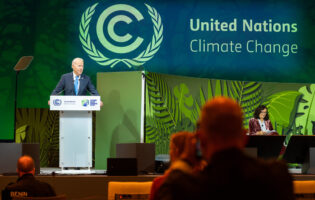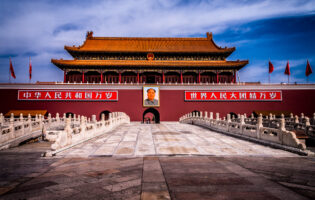
LUDOVIC MARIN/AFP/Getty Images
The United States, Germany, and WTO Reform: An Answer to the Rise of China?

Peter S. Rashish
Vice President; Director, Geoeconomics Program
Peter S. Rashish, who counts over 25 years of experience counseling corporations, think tanks, foundations, and international organizations on transatlantic trade and economic strategy, is Vice President and Director of the Geoeconomics Program at AICGS. He also writes The Wider Atlantic blog.
Mr. Rashish has served as Vice President for Europe and Eurasia at the U.S. Chamber of Commerce, where he spearheaded the Chamber’s advocacy ahead of the launch of the Transatlantic Trade and Investment Partnership. Previously, Mr. Rashish was a Senior Advisor for Europe at McLarty Associates, and has held positions as Executive Vice President of the European Institute, on the Paris-based staff of the International Energy Agency, and as a consultant to the World Bank, the German Marshall Fund of the United States, the Atlantic Council, the Bertelsmann Foundation, and the United Nations Conference on Trade and Development.
Mr. Rashish has testified on the euro zone and U.S.-European economic relations before the House Financial Services Subcommittee on International Monetary Policy and Trade and the House Foreign Affairs Subcommittee on Europe and Eurasia and has advised three U.S. presidential campaigns. He is a member of the Board of Directors of the Jean Monnet Institute in Paris and a Senior Advisor to the European Policy Centre in Brussels. His commentaries have been published in The New York Times, the Financial Times, The Wall Street Journal, Foreign Policy, and The National Interest, and he has appeared on PBS, CNBC, CNN, and NPR.
He earned a BA from Harvard College and an M.Phil. in international relations from Oxford University. He speaks French, German, Italian, and Spanish.
__
Contrary to expectations when China joined the World Trade Organization in 2001, the Beijing government has not steered a path for the country toward greater market openness. On the domestic front, burdensome conditions are often imposed on the operations of foreign companies in the Chinese market, including obligatory joint ventures with local companies that require the transfer of cutting-edge technologies to the Chinese partner. Internationally, state-owned enterprises (SOEs) and state-directed enterprises can benefit from government subsidies that are often not faithfully reported to the World Trade Organization (WTO) and that allow them to undercut competitors in third markets.
The United States has been sharpening its approach to China since the Obama administration, which pursued the Trans-Pacific Partnership (TPP) trade negotiations among twelve Asia-Pacific countries as a soft-power tool to nudge China to adopt high-standard economic rules. The Trump administration has taken a more power-based approach, jettisoning the TPP in favor of unilateral tariffs on Chinese imports, while the U.S. Congress passed the Foreign Investment Risk Review Modernization Act in 2018 to add new tools to the process governing the screening of inward investment in response to actual and potential Chinese company behavior abroad.
Germany’s Evolving Position Toward Chinese State Capitalism
While Germany had traditionally taken a more benign view of its economic relationship with China, that began to change in 2019. In January of this year, the Federation of German Industries published a paper called Partner and systemic competitor – How do we deal with China’s state-controlled economy? which states that a “competition is emerging between our system of a liberal, open and social market economy and China’s state-dominated economy” and that calls for “close and targeted coordination on China and its economic model with like-minded partners” including the United States. In February, German Federal Minister for Economics and Energy Peter Altmaier presented a Nationale Industriestrategie 2030 (National Industrial Strategy 2030) that can be seen in part as a response to Beijing’s “Made in China 2025” plan to dominate key industries of the future like artificial intelligence and robotics. And in March the European Commission released EU-China: A strategic outlook, which includes a strong critique of China’s protection of its domestic market—particularly the financial services sector—and its use of industrial subsidies.
While Germany had traditionally taken a more benign view of its economic relationship with China, that began to change in 2019.
The United States, Germany, and China are all members of the WTO, which as the guardian of the rules-based multilateral trading system should be a natural focus for creating rules that can encourage more market-based Chinese economic behavior. While some rules exist in the WTO that cover intellectual property, investment, and state-owned enterprises, they have not been updated since the institution’s founding in 1995 and in some cases do not provide straightforward guidance when disputes arise among its members. A good example of the inability of WTO rules to account for and discipline the non-market behavior of a country like China is the 2011 case concerning U.S. trade defense instruments (anti-dumping and anti-subsidy measures) used against Chinese SOEs. In that instance, the Appellate Body of the WTO’s Dispute Settlement Understanding opted for a narrow ruling that WTO law only covered entities (“public bodies”) that act like governments, rather than state-owned or controlled entities more generally, thus disallowing the U.S. actions.
The WTO Path and Its Limits
It is clear that there needs to be not only a modernization of the WTO’s rulebook, but also closer monitoring of its members’ trade policies and more effective enforcement when those policies infringe existing and future rules. But in nearly all cases the WTO requires a consensus of its members to make progress; beyond China, other emerging economies like India, South Africa, or Brazil may not wish to agree to new market-oriented disciplines that would limit the capacity of the state to steer the economy, depending on the issue. Although the U.S. and Germany, as well as the other members of the European Union, agree on both the diagnosis and the remedy on several key issues where reform in the WTO is needed—state-owned enterprises, forced technology transfers, subsidies, intellectual property, transparency and reporting, and special treatment for developing countries—because of the requirement for consensus it is uncertain (in the near term at least) whether the WTO route will bear fruit.
In parallel with steps at the multilateral level in the WTO the U.S. and Germany may find it advisable to strengthen their cooperation at the bilateral, trilateral, and plurilateral levels. These opportunities exist.
Beyond the Transatlantic Area: Expanding the Group of Like-Minded Economies
First, the U.S. and the EU could prioritize WTO reform within their bilateral trade talks launched in July 2018 by U.S. president Donald Trump and EU Commission president Jean-Claude Juncker, giving that issue equal weight with industrial tariffs and regulatory alignment. One area where there should be overlapping concerns is how to treat SOEs. The two sides could build on the text in the new U.S.-Mexico-Canada Agreement (which is itself based on the text from the Trans-Pacific Partnership). In addition to agreeing on a code of conduct for SOEs they could develop common transatlantic tools for enforcing that code.
Second, since December 2017 the U.S., the EU, and Japan have already been meeting in a trilateral format to discuss WTO reform. At their last meeting in January 2019, U.S. Trade Representative Robert Lighthizer, European Trade Commissioner Cecelia Malmstrom and Japanese Economy Minister Hiroshige Seko confirmed their commitment to continue working on issues including “nonmarket policies and practices, market-oriented conditions, industrial subsidies and state-owned enterprises, forced technology transfer policies and practices, WTO reform and digital trade and e-commerce.”
Third, and finally, there is the option of plurilateral agreements. The WTO explicitly permits groups of like-minded countries to move ahead on trade agreements under certain conditions. This was the case, for example, with the 1996 Information Technology Agreement that started out with twenty-nine WTO members and now counts eighty-two signatories. If the U.S. and their free trade agreement partners joined with Germany, the other members of the EU, and the EU’s FTA partners, there would be a critical mass of over 100 countries worldwide to move forward with new disciplines that could later be adopted by additional WTO members.
Success Begins at Home?
Although all of these approaches to encourage China to pursue more market-based trade and economic policies should be tried, given China’s determination to maintain its state-capitalist economic model it is not guaranteed they will succeed. That does not mean that the U.S. or Germany should resort to more unilateral or more power-based tools. On the contrary, the challenge from China is so great that no one country can hope to convince the country to change its course by itself. And as history has amply and painfully shown, the imposition of punitive tariffs hurts the importing country as much or more than the exporting country while at the same time undermining economic growth and orderly trading arrangements upon which prosperity depends.
The challenge from China is so great that no one country can hope to convince the country to change its course by itself.
In the end, the United States and Germany may need to rely as much on strengthening their domestic economies as on trade instruments to face up to the challenge from China. Fiscal and monetary policy; infrastructure upgrades; education, training, and retraining opportunities; and investment in new technologies like artificial intelligence may be the most dependable ways to ensure the continued leading position of the U.S. and Germany in the global economy of the future.








